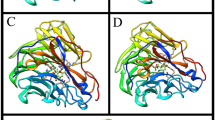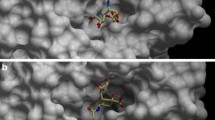Abstract
The avian influenza H5N1 virus has emerged as an important pathogen, causing severe disease in humans and posing a pandemic threat. Substrate specificity is crucial for the virus to obtain the ability to spread from avian to human. Therefore, an investigation of the binding properties of ligands at the molecular level is important for understanding the catalytic mechanism of the avian influenza virus neuraminidase and for designing novel and specific inhibitors of H5N1 neuraminidase. Based on the available crystal structure of H5N1, we have characterized the binding properties between sialic acid, methyl 3’sialyllactoside, methyl 6’sialyllactoside and the H5N1 influenza virus neuraminidase using molecular docking and molecular dynamics simulations. Obtained molecular dynamics trajectories were analyzed in terms of ligand conformations, N1-ligand interactions, and in terms of loop flexibility. It was found that in the N1-SA complex the sialic acid ring undergoes a transition from the B 2,5 to the 2 C 5 conformation. However, in the N1-3SL and N1-6SL complexes sialic acid remained in the distorted boat conformation. The obtained results indicate that 3SL has only weak interactions with the 150-loop, whereas the N1-6SL complex shows strong interactions. Most of the differences arise from the various conformations around the glycosidic linkage, between the sialic acid and galactose, which facilitate the above interactions of 6SL with the enzyme, and as a consequence the interactions between the 150- and 430- loops. This finding suggests that the altered flexibility of loops in and around the active site is one of the reasons why the avian N1 preferentially cleaves sialic acid from α-(2-3)-Gal glycoconjugates over α-(2-6)-Gal. These molecular modeling results are consistent with available experimental results on the specificity of N1.










Similar content being viewed by others
References
Webster RG, Bean WJ, Gorman OT, Chambers TM, Kawaoka Y (1992) Evolution and ecology of influenza a viruses. Microbiol Rev 56:152–179
Corfield AP, Higa H, Paulson JC, Schauer R (1983) The specificity of viral and bacterial sialidases for alpha(2-3)- and alpha(2-6)-linked sialic acids in glycoproteins. Biochim Biophys Acta 744:121–126
Rogers GN, Paulson JC (1983) Receptor determinants of human and animal influenza virus isolates: differences in receptor specificity of the H3 hemagglutinin based on species of origin. Virology 127:361–373
Franca de Barros J Jr, Sales Alviano D, da Silva MH, Dutra Wigg M, Sales Alviano C, Schauer R, dos Santos Silva Couceiro JN (2003) Characterization of sialidase from an influenza A (H3N2) virus strain: kinetic parameters and substrate specificity. Intervirology 46:199–206
Kobasa D, Kodihalli S, Luo M, Castrucci MR, Donatelli I, Suzuki Y, Suzuki T, Kawaoka Y (1999) Amino acid residues contributing to the substrate specificity of the influenza A virus neuraminidase. J Virol 73:6743–6751
Mochalova LV, Korchagina EY, Kurova VS, Shtyria JA, Gambaryan AS, Bovin NV (2005) Fluorescent assay for studying the substrate specificity of neuraminidase. Anal Biochem 341:190–193
Varghese JN, Laver WG, Colman PM (1983) Structure of the influenza virus glycoprotein antigen neuraminidase at 2.9 Ǻ resolution. Nature 303:35–40
Varghese JN, McKimm-Breschkin JL, Caldwell JB, Kortt AA, Colman PM (1992) The structure of the complex between influenza-virus neuraminidase and sialic-acid, the viral receptor. Protein Struct Funct Genet 14:327–332
von Itzstein M, Wu WY, Kok GB, Pegg MS, Dyason JC, Jin B, Phan TV, Smythe ML, White HF, Oliver SW, Colman PM, Varghese JN, Ryan DM, Woods JM, Bethell RC, Hotham VJ, Cameron JM, Penn CR (1993) Rational design of potent sialidase-based inhibitors of influenza-virus replication. Nature 363:418–423
Kim CU, Lew W, Williams MA, Liu HT, Zhang LJ, Swaminathan S, Bischofberger N, Chen MS, Mendel DB, Tai CY, Laver WG, Stevens RC (1997) Influenza neuraminidase inhibitors possessing a novel hydrophobic interaction in the enzyme active site: design, synthesis, and structural analysis of carbocyclic sialic acid analogues with potent anti-influenza activity. J Am Chem Soc 119:681–690
McCullers JA, Hoffmann E, Huber VC, Nickerson AD (2005) A single amino acid change in the C-terminal domain of the matrix protein M1 of influenza B virus confers mouse adaptation and virulence. Virology 336:318–326
de Jong MD, Thanh TT, Khanh TH, Hien VM, Smith GJD, Chau NV, Cam BV, Qui PT, Ha DQ, Guan Y, Peiris JSM, Hien TT, Farrar J (2005) Oseltamivir resistance during treatment of influenza a (H5N1) infection. N Engl J Med 353:2667–2672
Kiso M, Mitamura K, Sakai-Tagawa Y, Shiraishi K, Kawakami C, Kimura K, Hayden FG, Sugaya N, Kawaoka Y (2004) Resistant influenza A viruses in children treated with oseltarnivir: descriptive study. Lancet 364:759–765
Li KS, Guan Y, Wang J, Smith GJD, Xu KM, Duan L, Rahardjo AP, Puthavathana P, Buranathai C, Nguyen TD, Estoepangestie ATS, Chaisingh A, Auewarakul P, Long HT, Hanh NTH, Webby RJ, Poon LLM, Chen H, Shortridge KF, Yuen KY, Webster RG, Peiris JSM (2004) Genesis of a highly pathogenic and potentially pandemic H5N1 influenza virus in eastern Asia. Nature 430:209–213
von Itzstein M (2007) The war against influenza: discovery and development of sialidase inhibitors. Nat Rev Drug Discov 6:967–974
von Itzstein M (2008) Avian influenza virus, a very sticky situation. Curr Opin Chem Biol 12:102–108
Russell RJ, Haire LF, Stevens DJ, Collins PJ, Lin YP, Blackburn GM, Hay AJ, Gamblin SJ, Skehel JJ (2006) The structure of H5N1 avian influenza neuraminidase suggests new opportunities for drug design. Nature 443:45–49
Amaro RE, Minh DDL, Cheng LS, Lindstrom WM, Olson AJ, Lin J-H, Li WW, McCammon JA (2007) Remarkable loop flexibility in avian influenza N1 and its implications for antiviral drug design. J Am Chem Soc 129:7764–7765
Landon MR, Amaro RE, Baron R, Ngan CH, Ozonoff D, McCammon JA, Vajda S (2008) Novel druggable hot spots in avian influenza neuraminidase H5N1 revealed by computational solvent mapping of a reduced and representative receptor ensemble. Chem Biol Drug Des 71:106–116
Udommaneethanakit T, Rungrotmongkol T, Bren U, Frecer V, Stanislav M (2009) Dynamic behavior of avian influenza a virus neuraminidase subtype H5N1 in complex with oseltamivir, zanamivir, peramivir, and their phosphonate analogues. J Chem Inf Model 49:2323–2332
Schrödinger, LLC (2008) Jaguar, version 7.5, New York, NY
Zhao Y, Schultz NE, Truhlar DG (2006) Design of density functionals by combining the method of constraint satisfaction with parametrization for thermochemistry, thermochemical kinetics, and noncovalent interactions. J Chem Theory Comput 2:364–382
Varghese JN, Smith PW, Sollis SL, Blick TJ, Sahasrabudhe A, McKimm-Breschkin JL, Colman PM (1998) Drug design against a shifting target: a structural basis for resistance to inhibitors in a variant of influenza virus neuraminidase. Structure 6:735–746
Schrödinger, LLC (2007) Glide, version 4.5. New York, NY
Bernstein FC, Koetzle TF, Williams GJB, Meyer EF, Brice MD, Rodgers JR, Kennard O, Shimanouchi T, Tasumi M (1977) The Protein Data Bank: a computer-based archival file for macromolecular structures. Arch Biochem Biophys 112:535–542
Jorgensen WL, Maxwell DS, Tirado-Rives J (1996) Development and testing of the OPLS all-atom force field on conformational energetics and properties of organic liquids. J Am Chem Soc 118:11225–11236
Kaminski GA, Friesner RA, Tirado-Rives J, Jorgensen WL (2001) Evaluation and reparametrization of the OPLS-AA force field for proteins via comparison with accurate quantum chemical calculations on peptides. J Phys Chem B 105:6474–6487
Friesner RA, Murphy RB, Repasky MP, Frye LL, Greenwood JR, Halgren TA, Sanschagrin PC, Mainz DT (2006) Extra precision glide: docking and scoring incorporating a model of hydrophobic enclosure for protein−ligand complexes. J Med Chem 49:6177–6196
Case DA, Darden TA, Cheatham TEC III, Simmerling CL, Wang J, Duke RE, Luo R, Crowley M, Walker RC, Zhang W, Merz KM, Wang B, Hayik S, Roitberg A, Seabra G, Kolossváry I, Wong KF, Paesani F, Vanicek J, Wu X, Brozell SR, Steinbrecher T, Gohlke H, Yang L, Tan C, Mongan J, Hornak V, Cui G, Mathews DH, Seetin MG, Sagui C, Babin V, Kollman PA (2008) AMBER 10. University of California, San Francisco
Hornak V, Abel R, Okur A, Strockbine B, Roitberg A, Simmerling C (2006) Comparison of multiple Amber force fields and development of improved protein backbone parameters. Proteins 65:712–725
Kirschner KN, Yongye AB, Tschampel SM, Gonzalez-Outeirino J, Daniels CR, Foley BL, Woods RJ (2008) GLYCAM06: a generalizable biomolecular force field carbohydrates. J Comput Chem 29:622–655
Humphrey W, Dalke A, Schulten K (1996) VMD: visual molecular dynamics. J Mol Graphics Modell 14(33–38):27–38
Cremer D, Pople JA (1975) General definition of ring puckering coordinates. J Am Chem Soc 97:1354–1358
Tvaroška I, Carver JP (1997) Ab initio molecular orbital calculation of carbohydrate model compounds. 6. The gauche effect and conformations of the hydroxymethyl and methoxymethyl groups. J Phys Chem B 101:2992–2999
Vocadlo DJ, Davies GJ (2008) Mechanistic insights into glycosidase chemistry. Curr Opin Chem Biol 12:539–555
Spiwok V, Tvaroska I (2009) Conformational free energy surface of alpha-n-acetylneuraminic acid: an interplay between hydrogen bonding and solvation. J Phys Chem B 113:9589–9594
Shen T, Langan P, French AD, Johnson GP, Gnanakaran S (2009) Conformational flexibility of soluble cellulose oligomers: chain length and temperature dependence. J Am Chem Soc 131:14786–14794
Poppe L, Dabrowski J, Lieth C-W, Numata M, Ogawa T (1989) Solution conformation of sialosylcerebroside (GM4) and its NeuAc(α2 → 3)Galβ sugar component. Eur J Biochem 180:337–342
Poppe L, Stuike-Prill R, Meyer B, van Halbeek H (1992) The solution conformation of sialyl-alpha (2–6)-lactose studied by modern NMR techniques and Monte Carlo simulations. J Biomol NMR 2:109–136
Acknowledgments
This investigation was supported by grants from the Slovak Research and Development Agency under contract APVV-0607-07, from VEGA (grant No. 2/0128/08) and from the Centers of Excellence program of the Slovak Academy of Sciences (COMCHEM, Contract no. II/1/2007).
Author information
Authors and Affiliations
Corresponding author
Rights and permissions
About this article
Cite this article
Raab, M., Tvaroška, I. The binding properties of the H5N1 influenza virus neuraminidase as inferred from molecular modeling. J Mol Model 17, 1445–1456 (2011). https://doi.org/10.1007/s00894-010-0852-z
Received:
Accepted:
Published:
Issue Date:
DOI: https://doi.org/10.1007/s00894-010-0852-z




